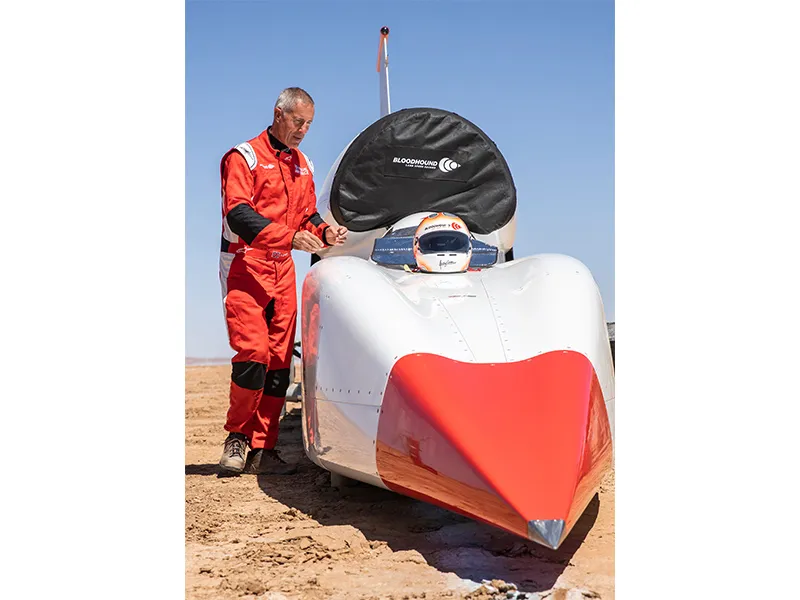800 MPH in a Jet-Powered Car
Bloodhound LSR rides the highway to the danger zone.
:focal(889x745:890x746)/https://tf-cmsv2-smithsonianmag-media.s3.amazonaws.com/filer/4f/53/4f53172b-e199-4254-a8cd-1551e702ee38/10c_dj2021_lsrcharliesperring2_live.jpg)
“I treat Bloodhound as a very low-flying airplane,” says Ron Ayers, the chief aerodynamicist for the Bloodhound Land Speed Record project—a Mach-busting car designed to exceed 800 mph.
“We’re trying to go faster at ground level than any jet fighter has,” says the project’s driver, Andy Green, a retired Royal Air Force fighter pilot. “No jet airplane has demonstrated sustained speed at low-level over 1,000 mph.”
Ayers and Green are no strangers to land-speed records. They were part of the team that worked on the Thrust SSC (supersonic car), which blazed across Nevada’s Black Rock Desert in 1997, setting the current world land-speed record of 763 mph. Ayers oversaw the aerodynamics and Green, who has thousands of hours in F-4 Phantoms and Eurofighter Typhoons, drove the car.
“Car” is almost a misnomer for the pointy-nose Bloodhound. Visually, the complex vehicle consists of a three-part stack: the chassis, which includes the driver’s cockpit; the engine; and a rudder perched atop the engine nacelle. Bloodhound is propelled by the same jet engine used in the Typhoon—a 20,000-pound-thrust Eurojet EJ200. But the EJ200 isn’t powerful enough to push Bloodhound well north of 800 mph, so the engine will be supplemented by a Norwegian-designed Nammo rocket. Tires would blow out at such incredible speeds; instead, the team has crafted solid aluminum wheels to glide along the desert hardpan.

In a video posted to YouTube just over a year ago, Bloodhound travels smoothly from 0 to 628 mph in 50 seconds, the Eurojet engine thundering in afterburner as a long plume of dust stretches behind it. Though you know otherwise, you keep waiting for Bloodhound to go airborne.
As hard as the team is working to give Bloodhound enough record-setting speed, they must also ensure that the car can safely decelerate. They’ve devised a three-stage system that begins by extending aerodynamic speed brakes. Then at around 600 mph, a drag chute is deployed—one of the most complex and unpredictable systems on the car. When Bloodhound slows to 200 mph, the driver can use the front disc brakes.
How a supersonic ground vehicle withstands drag and a shock wave and how it stays stable and controllable above Mach 1 are the critical challenges of Bloodhound’s aerodynamic design. Ayers is relying on computational fluid dynamics—basically virtual wind-tunnel testing. Data from 192 pressure sensors on the car feed sophisticated computer models.
Despite the advanced technology, things could still go wrong. “We’ve already done over 600 mph [in the Thrust SSC] so it’s well-traveled territory into the supersonic region,” says Ayers. “But it’s going further than that—in a different vehicle—so we’ll be taking every precaution you could imagine. It will be a very tightly controlled program: higher speed each time, assess the results, satisfy ourselves we’ve still got control—in measured step increases—until we’ve reached supersonic speeds with a decent margin.”
As Bloodhound travels faster, its speed can compromise its structural integrity. “We have plenty of strain gauges all over so we can detect something as it might happen and we can back off,” says Ayers. “We progress exactly as we would in testing a new supersonic aircraft.”
Green extends the analogy. “In terms of the technology, the speeds involved, and the decision-making processes, a lot of it is comparable to flying a supersonic jet fighter,” he says. “In some ways it’s a simpler task to just actually keep the vehicle on the ground on a prepared surface and [at a time] chosen when the weather is nice.”
In October 2019, the England-based team packed up the car and flew to South Africa for shakeout trials at the Hakskeen Pan salt flat in the Kalahari Desert. A month after arriving, Green put his foot down and blasted through 628 mph without the rocket assist.
His triumph was appreciated by Ian Warhurst, the Yorkshire businessman who is financing Bloodhound’s attempt to set a new land-speed record. Says Warhurst: “Hitting [628 mph] is a real milestone, and shows just what the team and the car can achieve.”
That speed milestone behind them, the team took Bloodhound back to England, along with billions of data bits ready for analysis. In particular, Ayers must determine the exact placement of the supplemental rocket necessary to boost Bloodhound’s velocity. That confirmed, the team plans to return to the South African desert in autumn 2021, perfect the jet-rocket hybrid, and go for the record.
